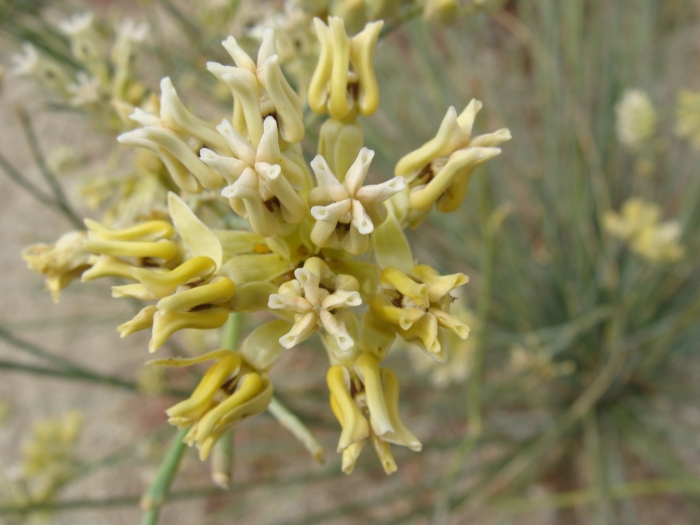Rush Milkweed
(Asclepias subulata)
Rush Milkweed (Asclepias subulata)
/
/

Alexis López Hernández
CC BY 4.0
Image By:
Alexis López Hernández
Recorded By:
Copyright:
CC BY 4.0
Copyright Notice:
Photo by: Alexis López Hernández | License Type: CC BY 4.0 | License URL: http://creativecommons.org/licenses/by/4.0/ | Rights Holder: Alexis López Hernández | Publisher: iNaturalist | Date Created: 2014-03-27T12:46:04-07:00 |

























Estimated Native Range
Summary
Asclepias subulata, commonly known as Rush Milkweed or Desert Milkweed, is a perennial herb native to the Sonoran and Mojave Deserts of the southwestern United States and northern Mexico. It is adapted to arid environments, often found in desert washes, flats, and rocky slopes. This species typically forms a cluster of slender, leafless stems, reaching heights of up to 4 feet (1.2 meters). The stems are green to gray-green and may appear waxy or slightly hairy. After its brief leafing period, it retains a stark, architectural quality with its naked stalks. The cream-white flowers, which bloom from spring to fall, have a unique structure with reflexed corolla lobes and a central crown of five shiny columns, each topped with tiny hooks. These flowers are followed by elongated follicles that split open to release flat, silky-haired seeds that are dispersed by the wind.
Rush Milkweed is valued for its drought tolerance and low maintenance requirements, making it an excellent choice for xeriscaping and naturalistic desert gardens. It is also significant for its role as a larval host plant for the monarch butterfly, contributing to butterfly conservation efforts. In cultivation, it thrives in full sun and requires well-drained soils, preferably sandy or gravelly substrates. It is highly tolerant of dry conditions and does not require frequent watering once established. While it is not commonly afflicted by diseases, it can be susceptible to root rot if overwatered or planted in poorly drained soils.CC BY-SA 4.0
Rush Milkweed is valued for its drought tolerance and low maintenance requirements, making it an excellent choice for xeriscaping and naturalistic desert gardens. It is also significant for its role as a larval host plant for the monarch butterfly, contributing to butterfly conservation efforts. In cultivation, it thrives in full sun and requires well-drained soils, preferably sandy or gravelly substrates. It is highly tolerant of dry conditions and does not require frequent watering once established. While it is not commonly afflicted by diseases, it can be susceptible to root rot if overwatered or planted in poorly drained soils.CC BY-SA 4.0
Plant Description
- Plant Type: Shrub, Herb
- Height: 2-4 feet
- Width: 2-4 feet
- Growth Rate: Slow
- Flower Color: Cream, White, Yellow
- Flowering Season: Spring, Summer, Fall
- Leaf Retention: Evergreen
Growth Requirements
- Sun: Full Sun
- Water: Low, Medium
- Drainage: Fast, Medium
Common Uses
Butterfly Garden, Drought Tolerant, Low Maintenance, Street Planting
Natural Habitat
Native to the Sonoran and Mojave Deserts
Other Names
Common Names: Desert Milkweed, Skeleton Milkweed
Scientific Names: , Asclepias subulata,
GBIF Accepted Name: